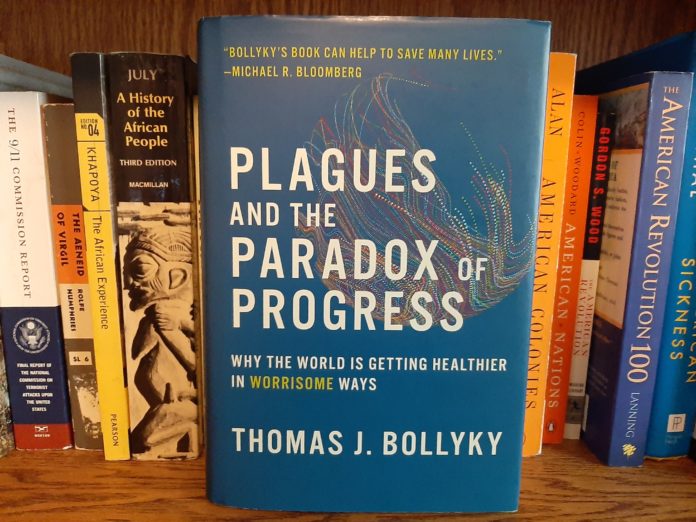
Photo: Urbanitus
Review: Plagues and the Paradox of Progress – Why the World is Getting Healthier in Worrisome Ways, by Thomas J. Bollyky, 2018, 280 pp., The MIT Press
Nearly seven full months since Chinese authorities released the sequence of the novel coronavirus that was causing strange cases of pneumonia in Wuhan, it seems nearly impossible now to imagine a time when infectious disease did not dominate our news and thoughts.
Plagues and the Paradox of Progress : Why the World is Getting Healthier in Worrisome Ways, is written by Thomas J. Bollyky, director of the global health program for the Council on Foreign Relations and adjunct professor of law at Georgetown University. Bollyky takes us back to that time, to the “Age of Miracles,” and as difficult as that is to believe now, an age of miracles it really was.
Thanks to immense efforts in fighting infectious disease around the world — through the development and distribution of more effective vaccines and treatments, generous foreign donors, improved access to clean water, and other preventative measures – the burden of infectious disease worldwide had fallen precipitously in the years leading up to the outbreak of COVID-19, especially in the developing world.
A few examples cited by Bollyky in his work:
- In 1980, after 10 years and 370 million vaccination doses, the World Health Assembly declared “the world and all its peoples have won freedom from smallpox, which was a most devastating disease.” This marked the first — and so far only — infectious disease to be eradicated.
- In 1950, there were nearly 100 countries in which one out of every five children would die before their fifth birthday, and the other four children that managed to survive to the age of five could only expect to live to the age of 42. By 2015, children born in a developing country could expect to live to the age of 70, and there is no longer any country in the world where one in five children will die before their fifth birthday.
- In 2003, about 100,000 people living with HIV/AIDS in Sub-Saharan Africa were receiving lifesaving treatments and by 2018 that number grew to more than 10 million.
Because of these gains in prevention and treatment – for the first time in humanity’s long and terrible struggle against microbes – the combined might of parasites, bacteria, viruses, and protozoa are no longer the leading cause of death in any major region of the world. For our species, this would seem like potentially our most extraordinary victory.
While celebrating these marvels of modern medicine and triumphs of aid efforts that reach beyond borders – in 2018 Bollyky still wanted us to worry. But why?
Three critical points of concern should be explored in more detail:
1) The rapid increase in life expectancy without the necessary social and economic environment needed to embrace the newly surviving adults and their changing health needs.
2) The emergence for the first time of the “poor world city.”
3) And, the removal of infectious disease from the lives and minds of most global citizens, creating a complacency that left us woefully unprepared for a new pandemic.
Life Expectancy without Infrastructure
First, Bollyky wants us to worry because the improvements in public health systems and governance, sanitation, and more responsible urban planning – progress that emerged naturally alongside the gradual fight against infectious disease and increase in life expectancy across centuries in Europe, North America, and a few other places such as Japan – remain in their incipient phase or do not exist in much of the developing world.
Pointing this out does not diminish the truly heroic efforts of generous donors and the tireless work of non-governmental organizations, whose efforts saved countless millions of lives in the developing world that would have been otherwise lost to infectious disease.
But because so much of this effort came from the international community, many developing countries remain dependent on these entities for their public health needs. Leadership in these countries –especially those mired in cycles corruption or conflict — do not have the resources, impetus, or in some cases the desire to develop their public health infrastructure.
Without this infrastructure, the developing world is left largely unprepared to handle the demographic changes happening as a result of more children surviving into adulthood. As populations age and fewer people die in childhood, the burden of disease typically shifts from acute conditions like an infection toward more chronic ailments such as ischemic heart disease, cancer, obesity, diabetes, and other non-communicable diseases; in turn, these diseases require substantially more developed public health systems and much more widespread and affordable access to effective care.
Further, the surge in population of working age adults in the developing world predominantly meets an an economic situation unable to integrate these adults into the workforce. In the developed world, the slow and painful fight against infectious disease happened alongside the equally slow and painful development of an economy evolving from agrarian to manufacturing and finally to the dominance of service and knowledge-based activities and mostly concentrate in established and planned urban areas. In the developing world, millions are flocking to cities from rural areas, but are not met with the manufacturing work that such migrants were drawn to a century ago in cities in places like Great Britain and the United States.
The Poor World City
Second, and as a direct consequence of the first issue of absent infrastructure, Bollyky wants us to worry about the emergence of a novel entity: the poor world city. This he defines as a city of at least 10 million residents that the World Bank classifies as low- or lower-middle-income. Examples today include Dhaka, Ho Chi Minh City, Kinshasa, Delhi, Mumbai, Jakarta, Karachi, Lagos, and Manila, among many others.
The experience of living in a city is a relatively new one, and the process of urbanization was slow for tens of thousands of years. In 1800, only approximately 3 percent of all humans lived in an urban area. Despite this, the city served as the epicenter for the worst public health experiences endured by humans, including the so-called “Black Death” of bubonic plague in the 14th Century that may have killed as many as 200 million people.
For nearly all of human history, large cities only existed as capitals of huge empires, such as Rome, Constantinople, Beijing, Saint Petersburg, and Baghdad. Pre-industrial cities were vulnerable to the devastation brought on by the plagues and famines that accompanied invading armies and merchants arriving from afar. It was they who brought diseases and vermin to people that lacked resistance and the modern medical knowledge to provide proper treatment.
More recently — during and after the Industrial Revolution — cities gradually began to develop and become more numerous as centers of manufacturing. Examples include London, Manchester, Paris, New York, and Chicago. These burgeoning cities could often offer rural migrants comparatively higher wages and more opportunities for gainful employment.
People flocked to European and North American urban areas to work in the factories and mills, and there they met an environment utterly nightmarish for human habitation. Cramped, sloppily constructed, and unregulated housing sprang up around urban areas. Livestock roamed the streets and often lived in close quarters with humans. Sanitation and public water were non-existent. And diseases such as cholera, typhus, and tuberculosis were rampant.
However, in both the cases of imperial capitals and centers of manufacturing, these cities benefitted from a slower pace of growth that enabled the gradual development of the necessary instruments of city planning, urban governance, public works, and public health as the cities grew over relatively long periods of time. Fewer of those who had moved to urban areas died, and by 1920, 14 percent of the world’s population now lived in an urban area, albeit heavily concentrated in Europe and North America.
The growth of the major cities of today do not follow this pattern, and Bollyky emphasizes this as a major cause for alarm.
Today, 55 percent of the world lives in an urban area and for the first time in history more people live in an urban area than those who do not, according to the United Nations. As of 2018, approximately 4.2 billion people live in an urban area worldwide, compared to just 751 million people in 1950.
By 2050, the UN estimates that 68 percent of the world’s population will live in an urban environment, adding another 2.5 billion people to urban populations worldwide. According to a 2018 report by the U.N. Department of Economic and Social Affairs, 35 percent of the growth in the global urban population is set to occur in just three countries: India, China, and Nigeria. By 2050, the report projects that India’s urban population will increase by 416 million people, China’s by 255 million people, and Nigeria’s by 159 million people.
By 2030, the U.N. projects that the number of megacities (cities with a population greater than 10 million inhabitants) will increase to 43. A total of 752 million people are projected to live in one of these 43 megacities, accounting for approximately 8.8 percent of the total global population. Some 90 percent of this growth in the population of megacities, and nine of the 10 emerging megacities themselves, are located within Asia or Africa.
Today, urban growth is happening not just in developing countries that are poor compared to their contemporary cities in North America and Europe, but also poorer than those now-developed countries were when they first urbanized in the nineteenth century. In 2005 dollars, the average income for a citizen in the United Kingdom in 1861 (the year the country became one-third urbanized) was about $5,000.
In 1920, when the population of the United States became over 50 percent urbanized, per capita income sat at about $7,500 in 2005 dollars. Meanwhile, in Sub-Saharan Africa, which reached about 37 percent urbanization in 2013, the per capita income was about $1,000 in 2005 dollars. And in the East Asia and Pacific region, per capita income sat at $3,620 when the region reached the one-third threshold in 1994.
So, what are the public health implications of this wealth disparity? Very simply put, unlike in the cities of North America and Europe of old, where urban growth happened because of improved public health institutions, the rapid growth of the modern megacities in the developing world is happening despite the presence of these institutions. In this new era, the existence of a large city is no longer a marker of economic prosperity or effective governance.
In one crucial passage, Bollyky explains:
“Poor cities have generally reversed the order by which urbanization has generally occurred in human history. When cities in wealthier nations were rife with disease, the move from farm to town was appealing to migrants only if there were prospects for jobs in factories and mills at a sufficiently high wage to justify the risk. The truly appalling sanitation and pollution and the high rates of deadly disease in those early cities kept the population gains from migration growing at a relatively slow pace. The only positive aspects of that otherwise unfortunate situation are the time it afforded countries to build wealth, an industrial base, and public health expertise, and the motivation it provided some social reformers, political elites, and ordinary citizens for improving sanitation, roads, and governance. This allowed the infrastructure and laws of American and European cities to slowly catch up to their growing number of residents.
“The economist Redi Jedwab and his colleagues have shown that much, if not most, of the population growth in many poor world cities is “natural”, meaning that cities like Delhi, Lagos, Cairo, and Karachi are growing more because their residents are living longer and their kids are not dying unnecessarily, rather than because more people are migrating to those urban areas.
“Jedwab, Vollrath, and other economists argue that the high rates of natural growth and congestion in many poor world cities, if they persist, will overwhelm the economic benefits that cities typically offer through agglomeration. In other words, the risk is that so many people may simply overwhelm the current urban water and sanitation systems, electrical grids, bridges, roads, and hospitals. In the last 10 years, according to the World Bank, the average driving speed in Dhaka has dropped from 21 kilometers per hour to 6 kilometers per hour, little faster than walking. That reduces the utility of that infrastructure, which deters investment and depresses wages. If that pattern persists, poor world cities will be a historical anomaly in another way: they will be the first to keep their residents poor rather than make them richer.”
As it was during the period of rapid urbanization following the Industrial Revolution in North America and Europe, among the most concerning trends today is the expansion of slums in cities worldwide.
As with the slums that existed in the nineteenth century of London and New York, today’s slums are characterized by the lack of proper sanitation and access to clean water, poorly constructed and informal housing structures, and residents with little to no security for their property rights. The difference, however, is that these 21st Century slums are proportionately larger and with far more stagnant income prospects than their 19th Century counterparts.
By 2014, the UN estimated that 881 million people in lower-income countries were living in slums, accounting for about 12.5 percent of the population of those countries. By 2030, the global population of those living in slums is expected to reach around 2 billion, which could equal more than a quarter of the world’s population.
Overcrowded, unsafe, and often disconnected from critical infrastructure, slum dwellings pose many serious health risks to their inhabitants. Unsurprisingly, close-quartered living conditions – as we are learning with COVID-19 — raise the risk of the spread of infectious diseases such as hepatitis, tuberculosis, cholera, dengue fever, and pneumonia, among others. Poor sanitation, lack of access to clean water, and overcrowding of toilet facilities lead to widespread diarrheal diseases – maladies that still account for one in 9 child deaths worldwide.
For example, in Nairobi’s largest and most notorious slum, Kibera, dwellings often sit right along open sewer lines, and the hundreds of thousands of residents within the slum share around 1,000 public toilets.
Since many slum dwellings are poorly constructed, lack proper insulation, and other necessary protections against harsh elements from the weather they are extremely vulnerable to theats including extreme heat, cold, and catastrophic weather events, all predicted to increase in frequency and severity as the globe continues to warm. Finally, slums tend to be located in heavily polluted or highly trafficked parts of the city, increasing their residents’ exposure to pollutants and other health hazards simply because of location.
Complacency and the Return of Pandemic
Third, and perhaps more newsworthy here in 2020 amid a pandemic, Bollyky wants us to worry about the way in which the threat of infectious disease seemingly fell off of the average person’s list of active concerns, and thus left our world unprepared to deal with a novel malady like COVID-19. And this goes for both the developed and developing spheres of the international community.
A few warning shots across our bow – including the SARS epidemic in East Asia 2003, the Ebola epidemic in West Africa in 2014, and especially the rapid, worldwide spread of Zika in 2015 – made headlines. However, these epidemics did little to instill a sense of urgency in most people and governments about the need to develop actionable plans to prevent the worst outcomes if, really when, a pandemic occurs. Though the specific nature of the coronavirus could not have been anticipated, little was done to prepare the world for an inevitable pandemic.
A few significant ways in which our world was poorly prepared for a novel pandemic:
- Widespread overuse of existing drugs and under-investment in developing new ones. Though the novel coronavirus that emerged in 2019 almost certainly could not have been prepared for in advance, a pandemic caused by antibiotic resistant bacteria remains well within the realm of immediate possibility.
- Viruses continue to emerge and move from animals to humans, especially as the climate changes and humans encroach on the natural world around them. While the specific origins of the novel coronavirus remain murky, almost certainly this is what happened at the end of 2019. And almost certainly it will happen again without a drastic shift in policy priorities worldwide to shift the way in which we interact with our environment.
- More than ever before, globalization and the explosion in widespread and relatively affordable international travel enables pathogens to spread around the globe with unprecedented speed. The novel coronavirus emerged in Wuhan, China, a city of over 11 million residents, connected by dozens of daily high-speed trains to other massive cities in the most populous country on earth, and connected by flights not only domestically but internationally.
- Developing nations still rely on foreign aid and non-governmental organizations to carry out a lot of their response to infectious disease. Amid a pandemic, these resources are likely to nearly evaporate, leaving under-developed health systems to fend for themselves in their response. As mentioned above, the necessity-driven development of established public health systems in the developed world has not similarly occurred in much of the developing world. The end results of this amid the current pandemic are of course unknown at this time. But the challenges are immense, especially in developing countries that have enormous urban areas such as India, the Philippines, and Nigeria.
- Despite perceived gains in the realm of international cooperation on public health that led to the eradication of smallpox and the near eradication of polio, the international system remains anarchic. Thus, amid a pandemic, nationalism and international competitiveness are likely to serve as a barrier to proper collective response and the sharing of scientific information. When confronting a disease as infectious as the novel coronavirus, even a successful eradication effort like the one in New Zealand does little long term good as long as the virus rages in countries such as the United States and Brazil.
Conclusions
To briefly conclude – this is the second time I have made my way through this critical work of scholarship. The first time was during the spring of 2019 when words like quarantine felt like almost something out of a science fiction movie, and now again as our world has been turned inside out and upside down by a terrible pandemic.
I am finding myself observing the global response to the coronavirus, as tragic and terrifying as it is, as merely a portent of future global health events.
One can only hope that Bollyky’s work and the many more that are likely to come from careful observation of recent events will reach the policymakers who need them to prepare us for the battles with infectious disease of tomorrow.
Without returning to concerted efforts to improve international cooperation, committing more resources to slowing and understanding the public health effects of climate change, and a renewing our focus toward providing the emerging poor world cities with the critical health infrastructure they need, our current crisis is nothing but a warm-up for what is to come.
Buy this book with a click to your local bookseller:If you like what you’ve been reading, please click here to subscribe and we will send you updates and our newsletter.






